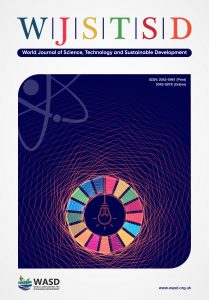Are sustainable buildings healthy? An investigation of lifecycle relationship between building sustainability and its environmental health impacts, Saheed Ajayi, Prof. Lukumon Oyedele, Babatunde Jaiyeoba, Kabir Kadiri and Sunday David
 Saheed O. Ajayi, Prof. Lukumon O. Oyedele
Saheed O. Ajayi, Prof. Lukumon O. Oyedele
Bristol Enterprise, Research and Innovation Centre (BERIC)
University of West of England, Bristol
UK
Email: ayolook2001@yahoo.co.uk
Babatunde Jaiyeoba, Kabir Kadiri, Sunday Aderemi David
Faculty of Environmental Design and Management
Obafemi Awolowo University, Osun
Nigeria
DOI: 10.1108/WJSTSD-01-2016-0015
Purpose: There have been speculations as to whether environmental friendly buildings are always healthy. Using lifecycle assessment (LCA) methodology, the purpose of this paper is to investigate lifecycle relationship between building sustainability and its environmental health impacts
Design/methodology/approach: In order to achieve this, a block of classroom was modelled with the aid of Revit software, and its lifecycle global warming potential (GWP) and human health impacts were analysed using green building studio and ATHENA impact estimator tools. Sensitivity analyses of the block of classrooms were then carried out by varying the building materials and energy use pattern of the original typology. The LCA was performed for seven alternative typologies that were achieved through variation in the building materials and energy use patterns.
Findings: For all the eight building typologies, the study shows a direct relationship between GWPs and human health impacts. This confirms that the more sustainable a building, the less its tendency for having negative health effects on building operatives, occupants and the wider environment. Again, the more green a building in terms of its materials and energy use pattern, the healthier the building becomes.
Research limitations/implications: The human health impacts was evaluated by measuring amount of particulate matter (PM2.5) produced by the buildings while environmental impact was evaluated by measuring global warming (KgCO2) potentials of the buildings throughout its lifecycle. The study has been based on the impacts of building materials and energy use patterns over the entire lifecycle of the buildings and materials used for construction.
Originality/value: The study established a positive relationship between GWP of building and its human health impacts. Thus, all arguments relating to the relationship between building sustainability and health are laid to rest by the paper.
Keywords: Sustainable environment; Assessment; Health; Environmental management; Global warming potential; Carbon emissions.
Citation: Ajayi, S.O., Oyedele, L.O., Jaiyeoba, B., Kadiri, K. and David, S.A. (2016), "Are sustainable buildings healthy? An investigation of lifecycle relationship between building sustainability and its environmental health impacts", World Journal of Science, Technology and Sustainable Development, Vol. 13 No. 3, pp. 190-204. https://doi.org/10.1108/WJSTSD-01-2016-0015

